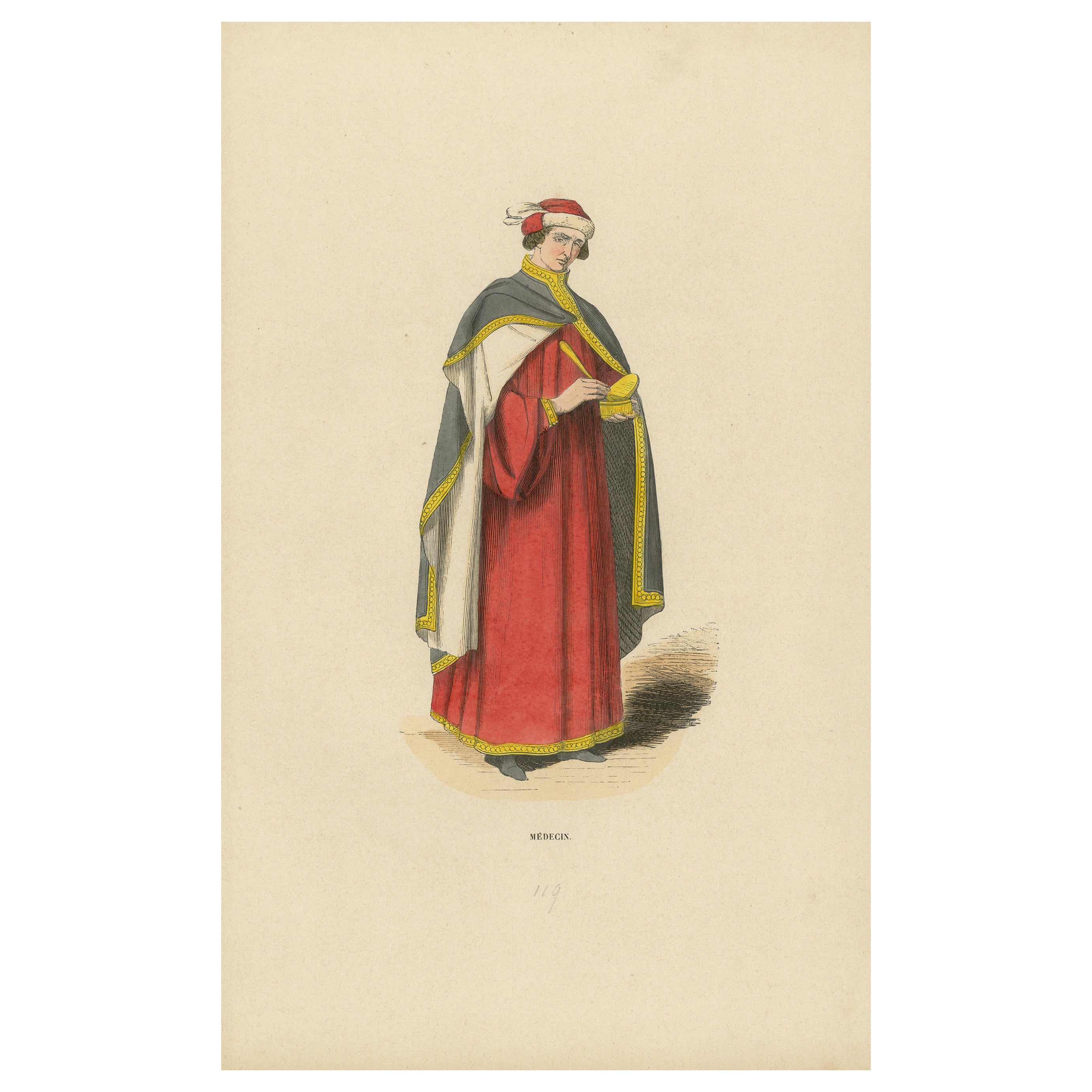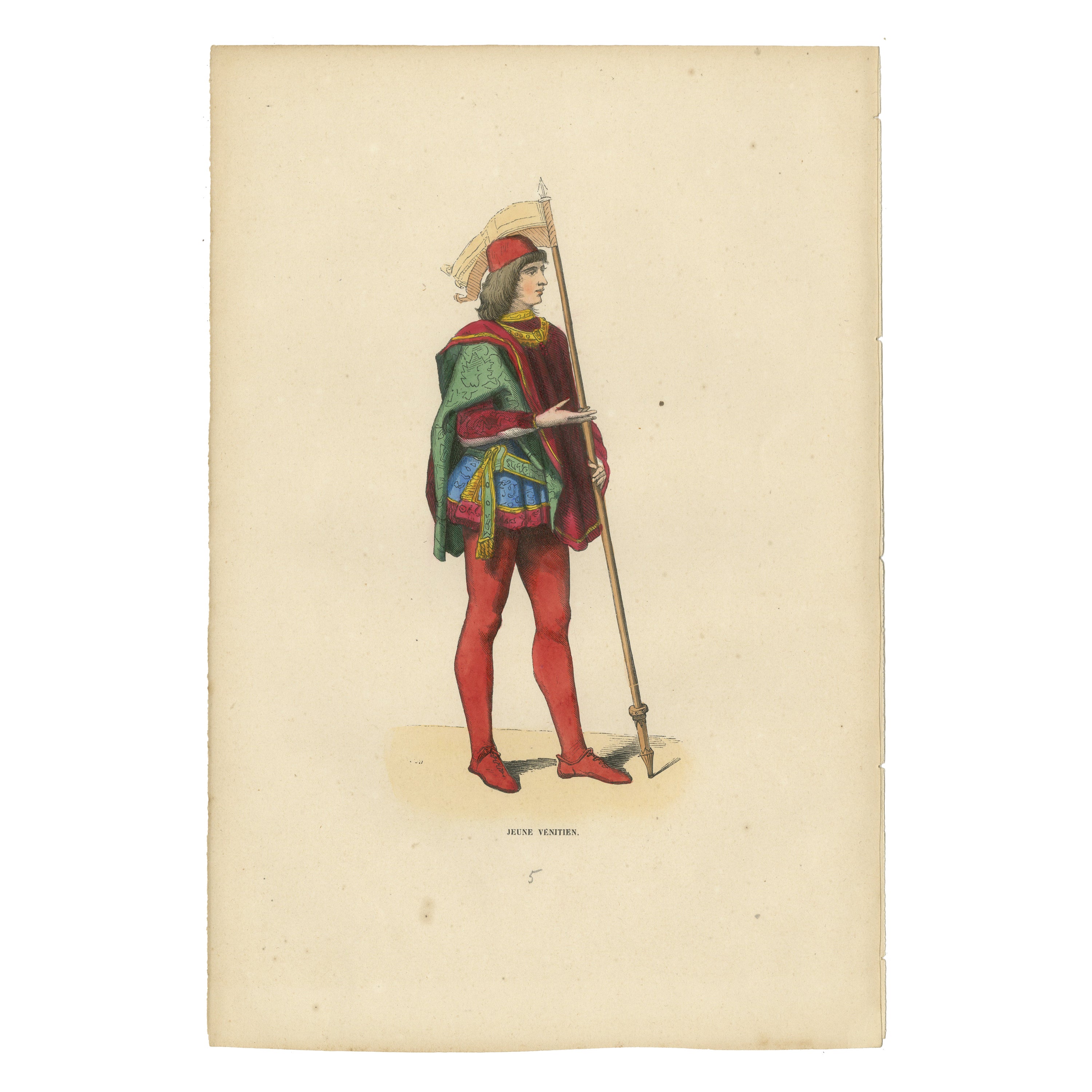Items Similar to Emissary of Tradition: Portrait of a Jewish Scholar from the Past, 1847
Want more images or videos?
Request additional images or videos from the seller
1 of 6
Emissary of Tradition: Portrait of a Jewish Scholar from the Past, 1847
About the Item
This original antique print depicts a figure labeled "JUIF," which is the French word for "Jew." The character is shown in traditional clothing that could be associated with a Jewish man of a historical period, possibly during the Middle Ages or Renaissance.
The man is wearing a long green robe with a red belt, and over it, a tan outer garment with brown detailing. He has a white hood or head covering that drapes over his shoulders. The attire suggests a humble yet dignified status, which may be indicative of the social position Jews held during the time period represented. His shoes are red, matching the belt, adding a small but significant pop of color to his outfit.
He is depicted in profile, with a full beard, and appears to be speaking or gesturing, giving him a look of engagement or discourse. The number "161" at the bottom suggests this print is part of a series, likely a collection illustrating various ethnic or social groups from history.
Given the historical context and the attire, a suitable title for this print could be "Portrait of a Jewish Scholar" or "Medieval Jewish Gentleman," depending on the intended representation of the figure's status.
The colors have a nice glow over them. Historically, egg whites, known as glair, and sometimes egg yolk were indeed used in illumination and painting, particularly in manuscripts, to give colors a brighter appearance and to add a sheen or gloss to the work. This technique was quite common during the Middle Ages and into the Renaissance.
Egg whites can be applied as a varnish over pigments to enhance their brightness and to protect the colors. This application could make the colors appear more vivid and also add a slight glossy sheen to the surface of the image.
Egg yolk, on the other hand, was commonly used as a binding agent in paint. It forms the basis of tempera paint, a medium that was widely used before the advent of oil painting. Egg yolk helps to create a durable and long-lasting color that adheres well to various surfaces.
In the context of the print from 1847, it's less likely that egg whites or yolks were used directly on the print, as by that time, commercial printing processes would have been more advanced and less reliant on such manual methods. However, if this print is a representation of an earlier style or is meant to mimic the appearance of hand-painted manuscripts, the original artists might have employed techniques or materials that gave a similar effect to those achieved with egg-based binders and varnishes.
- Dimensions:Height: 10.63 in (27 cm)Width: 7.09 in (18 cm)Depth: 0 in (0.02 mm)
- Materials and Techniques:
- Period:
- Date of Manufacture:1847
- Condition:Good. Overal light toning and light soiling but the image itself clean and hand-colored almost 200 years ago and still in expliciet colors. Aged paper with typically warm, yellowish-brown hue, mostly around the edges. Study the images carefully.
- Seller Location:Langweer, NL
- Reference Number:
About the Seller
5.0
Platinum Seller
These expertly vetted sellers are 1stDibs' most experienced sellers and are rated highest by our customers.
Established in 2009
1stDibs seller since 2017
1,919 sales on 1stDibs
Typical response time: <1 hour
- ShippingRetrieving quote...Ships From: Langweer, Netherlands
- Return PolicyA return for this item may be initiated within 14 days of delivery.
More From This SellerView All
- Scholar of the Arts: The Medieval Academic, 1847Located in Langweer, NLTitle: "Scholar of the Arts: The Medieval Academic" Description: This print illustrates a learned individual, likely a doctor of the arts or a scholar, from the medieval period. The...Category
Antique 1840s Prints
MaterialsPaper
- Everyday Grace: A Common Woman of the Past, 1847Located in Langweer, NLThe original antique print shows a seated figure labeled "Muger plebeia," which translates from Spanish to "Plebeian Woman" or "Common Woman." The woman is dressed in a simple yet elegant manner, indicative of the common people of the time. She is wearing a long dress in a pinkish hue with a red overdress or tunic, which drapes gracefully around her. On her head, she wears a blue hood that covers her hair, which was typical for women during various historical periods to denote modesty or as a fashion statement. Her seated position and the presence of the cane suggest rest or perhaps age. The simplicity of her clothing, without elaborate jewelry or adornments, signifies her status as part of the lower social class, although her clothing is neat and well-kept. Egg whites can be applied as a varnish over pigments to enhance their brightness and to protect the colors. This application could make the colors appear more vivid and also add a slight glossy sheen to the surface of the image. Egg yolk, on the other hand, was commonly used as a binding agent in paint. It forms the basis of tempera paint, a medium that was widely used before the advent of oil painting. Egg yolk helps to create a durable and long-lasting color that adheres well to various surfaces. In the context of the print from 1847, it's less likely that egg whites or yolks were used directly on the print, as by that time, commercial printing processes would have been more advanced and less reliant on such manual methods. However, if this print is a representation of an earlier style or is meant to mimic the appearance of hand-painted manuscripts...Category
Antique 1840s Prints
MaterialsPaper
- Scholar of the Codex: A Medieval Jurist in Study, 1847Located in Langweer, NLThe image depicts a person labeled "Docteur des Lois," which translates to "Doctor of Laws." This term historically refers to an individual who has achieved advanced scholarly status in the field of law, equivalent to the modern term "Juris Doctor." The figure is seated at a lectern, deeply engrossed in a large book, which likely represents legal texts or scholarly works. The individual is attired in a robe with a fur-lined cape, suggesting a status of academic or professional distinction. The robe is red, a color often associated with higher education and learning. The headwear appears to be a type of turban, which was a common academic regalia in certain cultures and times. The setting and attire suggest that this person is a scholar or a high-ranking legal professional, possibly a university professor or a magistrate from the medieval or Renaissance period. Egg whites can be applied as a varnish over pigments to enhance their brightness and to protect the colors. This application could make the colors appear more vivid and also add a slight glossy sheen to the surface of the image. Egg yolk, on the other hand, was commonly used as a binding agent in paint. It forms the basis of tempera paint, a medium that was widely used before the advent of oil painting. Egg yolk helps to create a durable and long-lasting color that adheres well to various surfaces. In the context of the print from 1847, it's less likely that egg whites or yolks were used directly on the print, as by that time, commercial printing processes would have been more advanced and less reliant on such manual methods. However, if this print is a representation of an earlier style or is meant to mimic the appearance of hand-painted...Category
Antique 1840s Prints
MaterialsPaper
- Attire of a Medieval Scholar: The Learned Physician of the Middle Ages, 1847Located in Langweer, NLTitle: "Attire of a Medieval Scholar: The Learned Physician of the Middle Ages" This hand-colored lithograph, titled "Médecin" in the original French, is a detailed portrayal of a m...Category
Antique 1840s Prints
MaterialsPaper
- Elegance of the Past: Margaret of York in 'Costume du Moyen Âge', 1847Located in Langweer, NLTitle: "Elegance of the Past: Margaret of York in 'Costume du Moyen Âge'" Description: This lithograph from the "Costume du Moyen Âge" series, published in 1847, portrays Margaret o...Category
Antique 1840s Prints
MaterialsPaper
- The Elegance of Venice: A Portrait of a Young Patrician, 1847Located in Langweer, NLThis original antique print depicts a young Venetian man, as indicated by the caption "Jeune Vénitien," which translates to "Young Venetian" from French. The young man is dressed i...Category
Antique 1840s Prints
MaterialsPaper
You May Also Like
- Andy Ducett Where Did You Come from? Memoirs from the past, Present, and FutureBy PhaidonLocated in New York City, NYPrint Digital archival print on Moab Entrada 335 gsm Measures: 32.00 x 44.00 in 81.3 x 111.8 cm Edition of 50This work comes with a signed and numbered label adhered to the back of each print. Andy...Category
2010s American Prints
MaterialsPaper
- Original Antique Print of A Bat, 1847 'Unframed'Located in St Annes, LancashireGreat image of a bat. Unframed. It gives you the option of perhaps making a set up using your own choice of frames. Lithograph after Cpt. brown with original hand color. Published...Category
Antique 1840s English Folk Art Prints
MaterialsPaper
- Original Antique Print of Seals, 1847 'Unframed'Located in St Annes, LancashireGreat image of seals. Unframed. It gives you the option of perhaps making a set up using your own choice of frames. Lithograph after Cpt. brown with original hand color. Published...Category
Antique 1840s English Folk Art Prints
MaterialsPaper
- Original Antique Print of a Hummingbird, 1847 'Unframed'Located in St Annes, LancashireGreat image of a hummingbird. Unframed. It gives you the option of perhaps making a set up using your own choice of frames. Lithograph after Captain Brown with original hand color....Category
Antique 1840s English Folk Art Prints
MaterialsPaper
- Original Antique Print of Dolphins, 1847 'Unframed'Located in St Annes, LancashireGreat image of dolphins. Unframed. It gives you the option of perhaps making a set up using your own choice of frames. Lithograph after Cpt. brown with original hand color. ...Category
Antique 1840s English Folk Art Prints
MaterialsPaper
- Original Antique Print of Parrots, 1847 'Unframed'Located in St Annes, LancashireGreat image of parrots. Unframed. It gives you the option of perhaps making a set up using your own choice of frames. Lithograph after Cpt. brown with original hand color. Publish...Category
Antique 1840s English Folk Art Prints
MaterialsPaper





